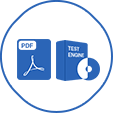Last Update 1 day ago Total Questions : 387
The Financial Risk and Regulation (FRR) Series content is now fully updated, with all current exam questions added 1 day ago. Deciding to include 2016-FRR practice exam questions in your study plan goes far beyond basic test preparation.
You'll find that our 2016-FRR exam questions frequently feature detailed scenarios and practical problem-solving exercises that directly mirror industry challenges. Engaging with these 2016-FRR sample sets allows you to effectively manage your time and pace yourself, giving you the ability to finish any Financial Risk and Regulation (FRR) Series practice test comfortably within the allotted time.
Which one of the following four statements on factors affecting the value of options is correct?
A credit risk analyst is evaluating factors that quantify credit risk exposures. The risk that the borrower would fail to make full and timely repayments of its financial obligations over a given time horizon typically refers to:
When looking at the distribution of portfolio credit losses, the shape of the loss distribution is ___ , as the likelihood of total losses, the sum of expected and unexpected credit losses, is ___ than the likelihood of no credit losses.
To safeguard its capital and obtain insurance if the borrowers cannot repay their loans, Gamma Bank accepts financial collateral to manage its credit risk and mitigate the effect of the borrowers' defaults. Gamma Bank will typically accept all of the following instruments as financial collateral EXCEPT?
Which one of the following four model types would assign an obligor to an obligor class based on the risk characteristics of the borrower at the time the loan was originated and estimate the default probability based on the past default rate of the members of that particular class?
In the United States, Which one of the following four options represents the largest component of securitized debt?
ThetaBank has extended substantial financing to two mortgage companies, which these mortgage lenders use to finance their own lending. Individually, each of the mortgage companies has an exposure at default (EAD) of $20 million, with a loss given default (LGD) of 100%, and a probability of default of 10%. ThetaBank's risk department predicts the joint probability of default at 5%. If the default risk of these mortgage companies were modeled as independent risks, what would be the probability of a cumulative $40 million loss from these two mortgage borrowers?

